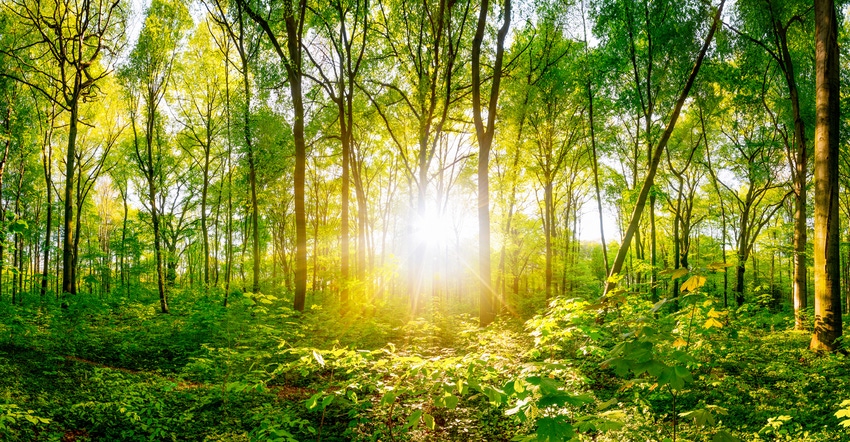March 18, 2022

Riparian and upland forest buffers can be part of an overall agroforestry program. Simply put, agroforestry is a combination of intensive land use management practices that combine woody plants like trees and shrubs with crops and/or livestock operations. Some examples include alley cropping, riparian and upland forest buffers, windbreaks, silvopasture, and forest farming.
But let’s dive into riparian and upland forest buffers first.
Some terminology: “Riparian” is a term that refers to a flood plain. Riparian forest buffers are strips of vegetation designed to connect land with water bodies such as creeks, lakes and rivers. Buffers help improve water quality and aquatic life.
What are they not? They’re not a hodgepodge of plants growing along a stream bank. They need to be carefully designed and maintained to maximize benefit. And you need to choose the right plants for your conditions. Here’s a closer look.
Riparian forest buffers
Riparian forest buffers consist of three zones with a recommended effective width of 180 feet.
Zone 1. This is the closest to the bank of the water body and consists of native bottomland trees, shrubs and forbs that are quick to establish and stabilize the stream bank, and that can tolerate periodic or chronic flooding and saturated soils.
Zone 2. This middle zone is much wider and is contiguous with Zone 1. It consists of woody plant species that also can tolerate flooding and a high water table. Upland woody plants can be used in areas with lower water tables. The main purpose of Zone 2 is to facilitate nutrient uptake and storage, and to reduce flooding. Multi-stemmed shrubs can be effective in reducing floodwater velocity and trapping floating debris that may end up in crop fields or pastures. Depending on the plants used, Zone 2 can provide supplemental income from nut- and fruit-bearing plants, woody stems for floral arrangements, biomass, and wildlife habitat (think hunting rights).
Zone 3. This zone borders crop fields and pastures and is designed to facilitate high water infiltration, trapping of sediment, nutrient uptake (like excess fertilizer) and reduced flooding. You can use native grasses and forbs, along with rigid-stemmed introduced grasses. You can also harvest and sell seeds from these plant, or use the grasses for livestock forage or biomass.
Upland forest buffers
Upland forest buffers are similar but consist of planted trees, shrubs, grasses and forbs that follow natural contours of upland watersheds, particularly within crop fields. Their benefits are similar to riparian forest buffers, but they’re only 6 to 16 feet wide and do not require specific plant zones.
An important note: Upland forest buffers are not the same as alley cropping or windbreaks. Their main function is to reduce nonpoint pollution, soil erosion and formation of gullies.
As mentioned previously, neither of these buffers happen by accident. You have to design and maintain them. Their planning, design and development must include the landowner’s objectives and concerns, including the function of the buffer, current land use, soils and topography, local hydrology, short- and long-term management goals, potential government funding grants, and potential markets for nonfarm income like food and floral crops, or hunting rights.
As with any endeavor, there are advantages and disadvantages. Both buffers help reduce soil erosion, improve water quality and habitat, can be a source of additional farm income, provide wildlife habitat, and increase carbon storage. But both buffers also require intensive management, result in loss of crop land or pasture, can compete with crops for water, and can present challenges for tiling and drainage.
For more information on agroforestry, and riparian and upland forest buffers, contact your local Extension office or check out these sites:
• The Center for Agroforestry at the University of Missouri
• USDA National Agroforestry Center
• The Savanna Institute
• USDA Agricultural Research Service
• Natural Resources Conservation Service
Miller is a horticulture professor at Joliet Junior College in Joliet, Ill., and a senior research scientist in entomology at The Morton Arboretum in Lisle, Ill. Email your tree questions to him at [email protected]. The opinions of this writer are not necessarily those of Farm Progress/Informa.
About the Author(s)
You May Also Like




